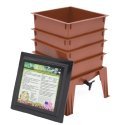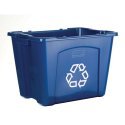What is Worm Compost?
To most, Worm Compost is a rhetorical statement, because when thinking about compost, worms are usually one of the fist things to come to mind. A worm does one thing in its whole existence, compost nutritious and valuable fertilizer that can be used in gardens to enrich the growth and development of tasty veggies. More specifically, worms eat the rot off of rotting organic materials, and in exchange, leave behind what we call worm castings.
Worms have been eating organic waste for millions of years and returning nutrients back to the soil, they can breakdown pretty much any organic material, but they have their preferred kinds of food. When doing worm composting, regular earth worms can be somewhat ineffective due to the low concentration of soil. Usually the term Vermicomposting is used when using eisenis fetida or lumbricus rubellus, (red worms), as well as brown nose wigglers. These guys just love kitchen scraps. They can take nutrient rich fruits and vegetables and turn them into nutrient rich compost, within just a few months. A good body of red worms and bedding of moist newspaper strips with some dry leaves, a little soil and a hand full of sand, mixed together inside a cool, dark box under the sink or out in the backyard, away from noisy traffic and dishwashers, could make the perfect place for worm compost.
Red worms can actually double their population within 90 days, when fed properly. Red worms eat about 1 pound of kitchen scraps per pound of themselves in a week. This gets even better for the more space they have to crawl around. The final results are worm castings. And can take some two to three months to be ready in some cases maybe twice that, but once completely transformed, worm compost is a wonderful additive for plants to grow big and strong.
Harvesting worm castings can be a fun and exiting process. For children who are learning about the process, its exiting to separate them by hand, from the finished castings, by gently dumping the whole compost over a tarp and picking them out one by one, but there are easier methods, which can be just as exiting. Worms, are not thermophylic composters. They prefer the very early and latter cooler stages of composting in itself. When said and done, a compost pile left directly in contact with the ground but still properly protected from the rain and elements, will attract worms from out of the ground and into the pile, but once the thermophylic process begins, this situation will change as worms really don’t like heat.
And it is with heat that worms can be convinced out of the finished castings. Just put a few piles around the outer edges of the tarp, and place a lamp light directly on each pile facing in and the worms will all migrate out of their finished castings and into the center of the tarp, where they can be easily collected and given more tummy filling work to do. Which is probably the most remarkable thing about worm compost in and of itself, worm compost means they really will enjoy what they do. Worm compost, in this way, could perhaps by a synonym for humankind in harmony with nature.





